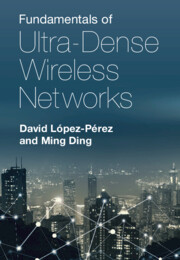Book contents
- Frontmatter
- Dedication
- Frontmatter
- Contents
- About the Authors
- Foreword
- Foreword
- Preface
- Acknowledgements
- List of Abbreviations
- Part I Getting Started
- 1 Introduction
- 2 Modelling and Analysis of Ultra-Dense Wireless Networks
- 3 Performance Analysis of Traditional Sparse and Dense Wireless Networks
- Part II Fundamentals of Ultra-Dense Small Cell Networks
- Part III Capacity Scaling Law
- Part IV Dynamic Time Division Duplexing
- References
- Author Index
3 - Performance Analysis of Traditional Sparse and Dense Wireless Networks
from Part I - Getting Started
Published online by Cambridge University Press: 17 June 2022
- Frontmatter
- Dedication
- Frontmatter
- Contents
- About the Authors
- Foreword
- Foreword
- Preface
- Acknowledgements
- List of Abbreviations
- Part I Getting Started
- 1 Introduction
- 2 Modelling and Analysis of Ultra-Dense Wireless Networks
- 3 Performance Analysis of Traditional Sparse and Dense Wireless Networks
- Part II Fundamentals of Ultra-Dense Small Cell Networks
- Part III Capacity Scaling Law
- Part IV Dynamic Time Division Duplexing
- References
- Author Index
Summary
Chapter 3 summarizes the modelling, derivations and main findings of probably one of the most important works on small cell theoretical performance analysis, which concluded that the fears of an inter-cell interference overload in small cell networks were not well-grounded, and that the network capacity – or in more technical words, the area spectral efficiency – linearly grows with the number of deployed small cells. This research was the cornerstone of much of the research that followed on small cells performance analysis.
Keywords
- Type
- Chapter
- Information
- Fundamentals of Ultra-Dense Wireless Networks , pp. 73 - 100Publisher: Cambridge University PressPrint publication year: 2022

